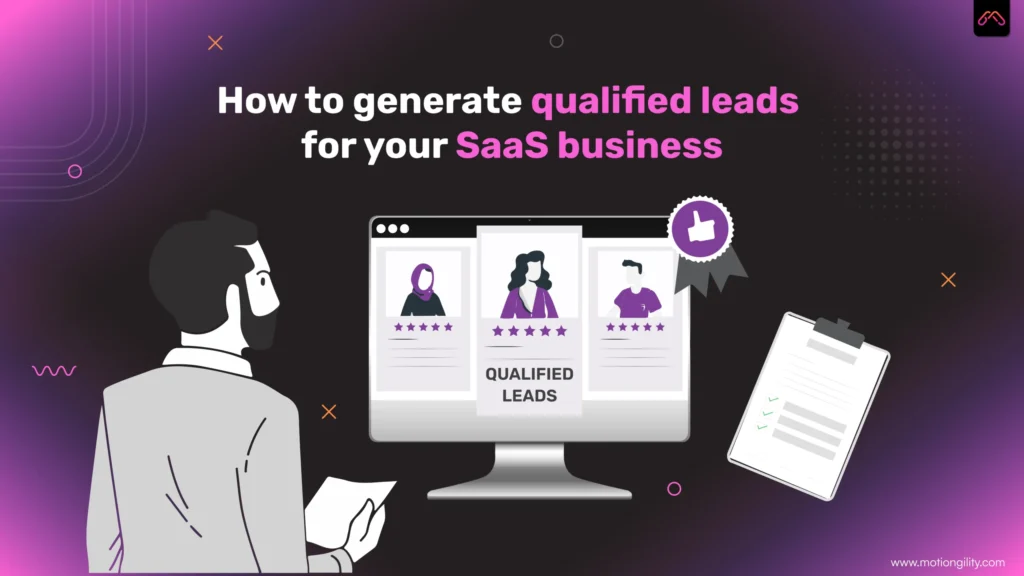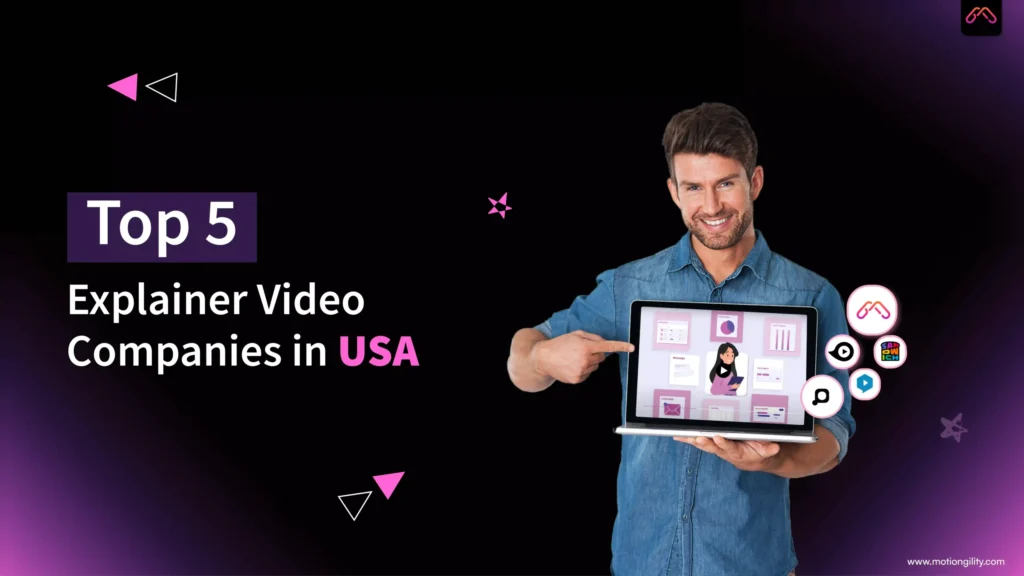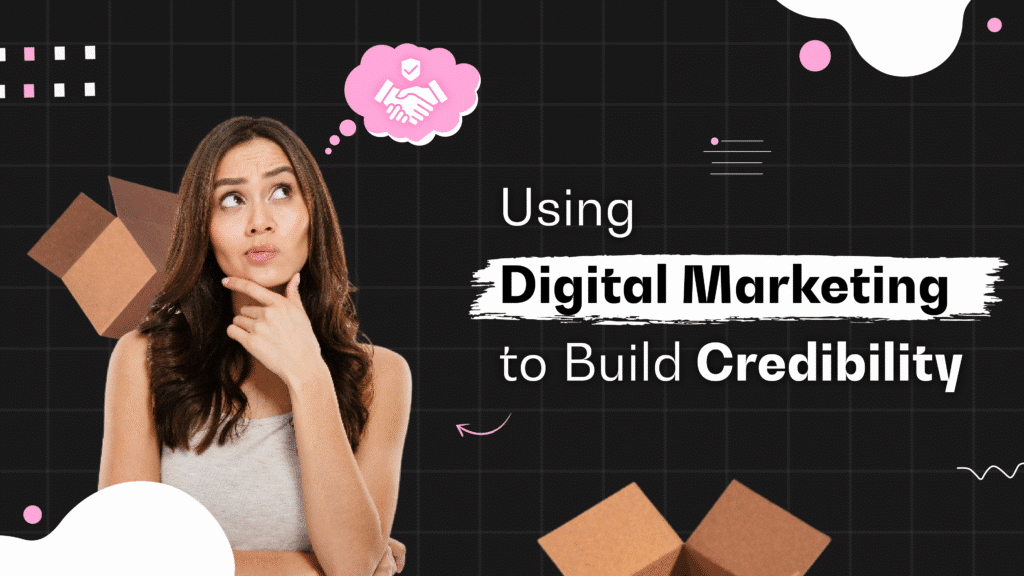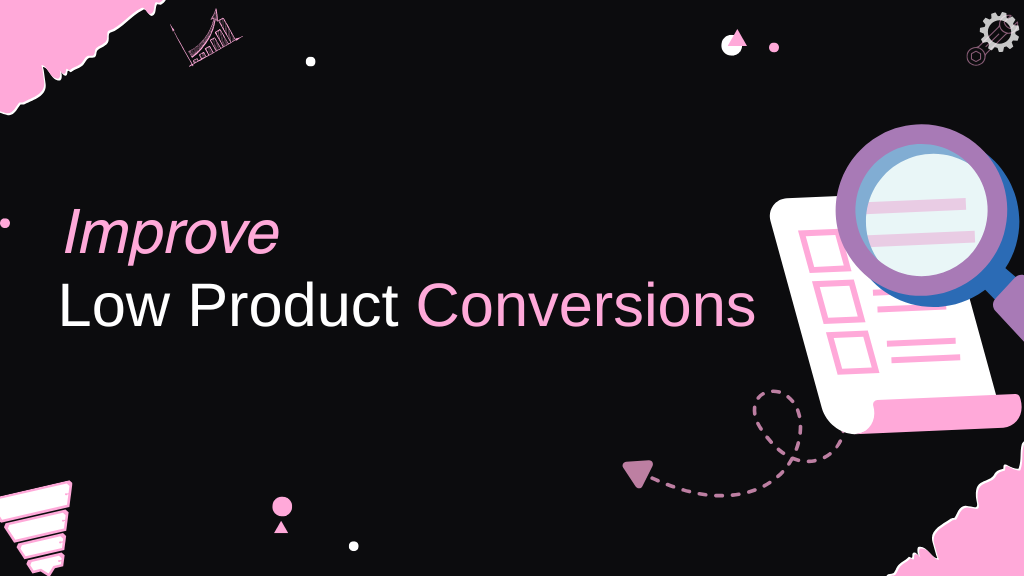If you’re building or running a SaaS business, your growth can’t happen without leads. But getting leads isn’t the hardest part. Almost every SaaS company can collect emails, get free trial sign-ups, or attract webinar attendees.
But the sad truth is, most of these leads won’t actually buy. Probably, they don’t need your product, don’t have the budget, or are not ready to make a decision yet.
So, your real challenge is generating qualified leads through effective SaaS lead generation. Imagine opening your CRM filled with people who are interested in your product, can afford it, and are ready to buy.
What else would a SaaS owner need in life? Your competitors are already building pipelines full of leads who actually convert. Why not you?
That’s why we created this guide, where we’ll show you how to execute SaaS lead generation the right way, step by step. But let’s first explain exactly what a qualified lead is.
What Are Qualified Leads in SaaS?
A qualified lead is one who fits your ideal customer profile (ICP), has an actual need for your product, and can make a buying decision.
But not all qualified leads are created equal. In SaaS, you’ll come across all kinds of people who interact with your brand: blog readers, someone who downloads a lead magnet, or one who’s actively talking to sales.
The problem? They’re all at different levels of readiness to buy. That’s why it’s crucial to understand the breakdown of qualified leads:
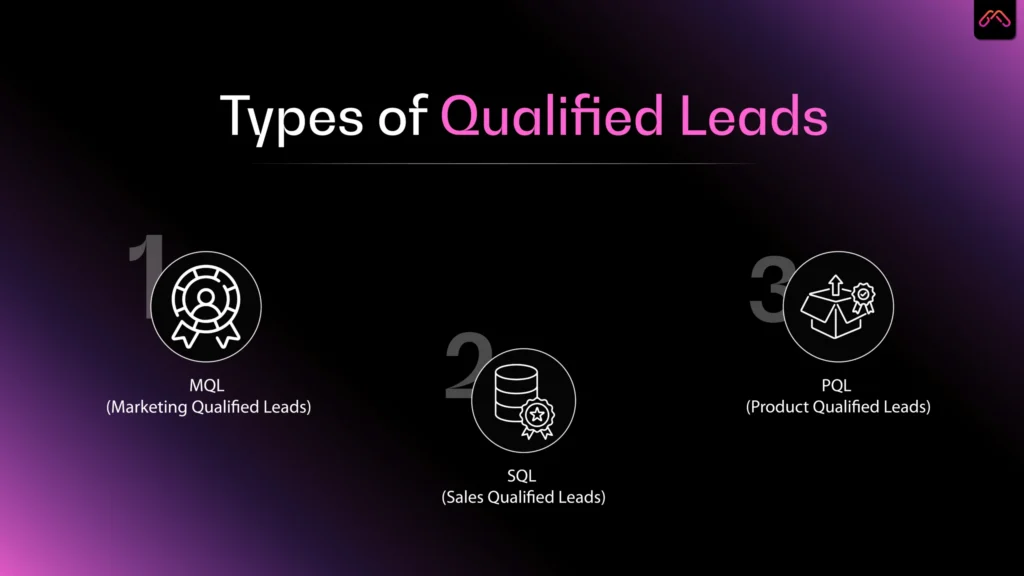
1. MQL (Marketing qualified lead)
MQLs show enough interest in your marketing to suggest they might buy. For example, someone who attended your webinar or downloaded a case study. They’re not yet ready to talk to sales, but are worth nurturing.
2. SQL (Sales qualified lead)
SQLs are vetted by your sales team and considered ready for direct sales outreach. A lead who requested a demo and fits your ICP will qualify as an SQL.
3. PQL (Product qualified lead)
PQLs have already used your product in some form (via free trial or freemium) and shown intent to upgrade. For instance, a team trial user inviting multiple teammates is a PQL.
Once you know what a qualified lead looks like, the next question is: how do you actually get them into your funnel? Because that’s one of the SaaS problems every founder faces.
12 SaaS Lead Generation Strategies
We’ve compiled 12 proven SaaS lead generation techniques to boost conversions and consistently attract and convert qualified leads for SaaS.
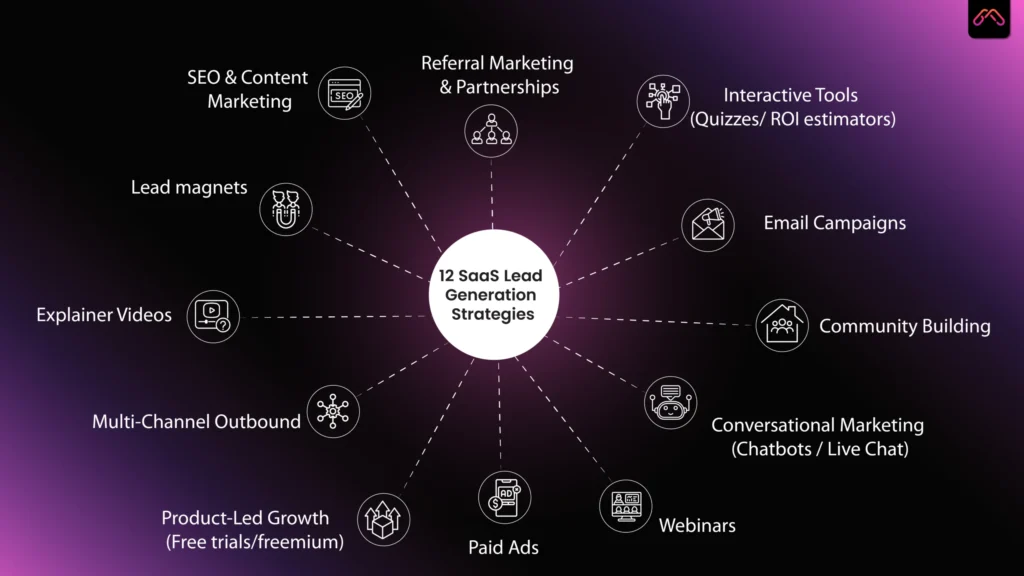
1. SEO & Content Marketing
In SaaS marketing, content is one of the most sustainable ways to generate leads because SaaS buyers mostly start their research with search engines, and visibility in these moments is critical.
But what to present to your prospects? I believe, if you’re running SaaS, you already know your buyer’s persona, which is their demographics, pain points, desires, etc.
Next, create educational and bottom-of-funnel content that nurtures visitors from awareness to decision. But, don’t start randomly; ensure what you publish goes in front of your prospects.
That’s where strong SEO makes your content discoverable by optimizing your blogs with keywords people are searching for. SaaS lead generation efforts benefit the most from this, as companies generate up to 34% of their qualified leads through SEO, more than any other channel, according to SageFrog’s 2025 stats.
2. Lead Magnets
Sometimes, your audience needs a little incentive to share their details – a lead magnet. It’s a free and valuable offer you provide as a business in exchange for a potential customer’s contact information, such as an email address.
Most folks assume lead magnets are just ebooks, but no! Templates, quizzes, calculators, whitepapers, and checklists – all count as lead magnets.
It’s reported that companies using targeted lead magnets in SaaS lead generation report up to 300% more leads than generic approaches.
But, how to decide what lead magnet suits your Saas? See, there’s no direct answer, but ebooks are considered the best among all because they show you’ve put effort into writing a 10 or 20-page solution to your audience’s problem.
Also, remember that interactive and educational lead magnets (e.g., quizzes, calculators, resource guides) get up to 70% higher conversion rates than generic eBooks or newsletters.
3. Explainer Videos
Hey, not everyone is interested in what you’re doing right now: reading, no matter how valuable it is. You can’t convince users to read walls of text, but they can happily watch a video.
SaaS brands know how to use video effectively, so they opt for explainer videos: short and engaging videos created to communicate complex ideas, products, or services.
Explainer videos break down your SaaS product into simple visuals, making it easy for prospects to understand what you do and why it matters. Plus, explainer videos, when featured on landing pages, lift conversion up to 86%, making them a powerful SaaS lead generation asset.
Today, many SaaS companies use demo videos, product walkthroughs, or customer success stories to turn website visitors into qualified leads.
Below, see how Karya Cloud, a Business Management SaaS, smartly conveys its platform idea to the audience in one of these SaaS explainer video examples:
4. Multi-Channel Outbound
Cold outreach may sound a bit traditional, but when executed well, it often delivers some of the fastest, most qualified leads for SaaS businesses.
And, outreaching via more than one channel is gradually becoming the norm in the SaaS industry because multi-channel campaigns improve SaaS lead generation by around 31% vs single-channel ones.
To get the best results, first define your ICP and be as narrow as possible. Why? The more personalized your message, the more replies you’ll receive.
Next, shoot your message across channels: email, LinkedIn message/Inmail, cold call, or any messaging platform. Most replies won’t come from the first try. Data shows follow-ups can boost reply rates by 100-200% compared to just one email.
Simultaneously, keep track of which channels bring in replies, which messages convert into meetings, and which sequences generate ROI. Calculate and shift your budget or time toward the most productive SaaS lead generation channels.
5. Paid Ads
If you want to accelerate SaaS lead generation and growth, paid acquisition is hard to ignore. Google Ads, LinkedIn campaigns, and retargeting on Facebook can quickly put your SaaS in front of high-intent buyers.
For SaaS businesses, paid ads work best when you focus on bottom-of-funnel intent, people already searching for solutions like yours.
Platforms like Google let you capture these users through keywords, while LinkedIn helps you reach decision-makers by job title, company size, and industry. Retargeting then nurtures visitors who didn’t convert the first time, keeping your brand top of mind.
Combine this with precise tracking, like UTM parameters (tags added to URLs to track ad performance) and CRM integration (syncing ad data with your sales system to trace lead sources), to see which channels bring in qualified SaaS lead generation opportunities, not just traffic.
6. Product-Led Growth
Instead of relying solely on marketing and sales, Product-Led Growth (PLG) lets the product drive SaaS lead generation and conversion through free trials, freemium plans, or interactive demos.
This hands-on experience means users qualify as Product-Qualified Leads (PQLs) and convert 2–3x better than MQLs or SQLs. Since buyers explore at their own pace, PLG also cuts customer acquisition costs (CAC) by up to 60% and shortens sales cycles.
In short, PLG helps you attract, qualify, and convert leads faster because instead of convincing users why your SaaS works, you let them feel it. The product becomes your best marketer and salesperson, too.
7. Webinars
Webinars have become one of the most effective channels for qualified SaaS lead generation, combining education, engagement, and intent in one format.
According to industry data, 83% of marketers say webinars bring in high-quality leads, and 62% of attendees show interest in a sales demo after a session, a level of intent few other inbound channels can match.
Unlike blogs or static videos, webinars allow real-time interaction through Q&As, polls, and live demos, which build trust and showcase product value instantly.
Webinars are also cost-efficient, and 65% of marketers repurpose webinar content into blogs, short clips, or guides, extending their ROI. For complex SaaS products, webinars don’t just inform but pre-qualify, nurture, and convert leads who’ve already seen the value firsthand.
8. Conversational Marketing
Conversational marketing is changing SaaS lead generation by replacing static forms with instant and real-time engagement.
Instead of waiting hours or days for responses, live chat tools engage visitors the moment they land on a site: answering questions, qualifying prospects, and connecting hot leads to sales teams immediately.
Qualified mentioned that companies using conversational marketing see up to a 70% increase in MQLs and 10x more sales conversations.
It’s because these tools operate 24/7, ensuring lead capture and qualification even outside business hours.
9. Community Building
Community building generates qualified leads for SaaS companies, not by pushing sales, but by sharing your product information where users learn, engage, and adapt with your brand.
If you have a strong community, you can turn satisfied customers into your best marketers.
According to Crunch Marketing, over 60% of SaaS brands that invest in community-driven strategies see a significant rise in qualified leads, while those with active user groups experience up to a 30% lower customer acquisition cost (CAC).
Plus, communities also drive better retention; users acquired through referrals are 65% more loyal and convert up to 50% faster than cold leads.
To build your own SaaS community, start by hosting niche forums, webinars, or Slack groups around customer success, encourage user-generated content, and reward top contributors.
If done right, your community will become an ecosystem that attracts and qualifies leads while enhancing your brand’s credibility.
10. Email Campaigns
Email marketing isn’t just about sending newsletters; it’s about building a smart, automated system that consistently nurtures and qualifies SaaS leads. Start by segmenting your audience based on behavior, lifecycle stage, or product interest.
For example, send personalized messages to free-trial users, existing customers, or cold leads rather than sending a single email to all.
Next, set up automated workflows: welcome sequences, feature onboarding, and re-engagement campaigns. These sequences guide users naturally through the funnel and educate them at every step.
You can take inspiration from Mailchimp, which uses drip campaigns that showcase product value and convert free users into paying customers.
Finally, track performance using UTM parameters to understand which emails drive demo signups or conversions, and integrate your campaigns with a CRM like HubSpot or Salesforce for better SaaS lead generation insights.
11. Interactive Tools
Sometimes the best way to generate leads is to give prospects something they can use. Interactive tools like quizzes or self-assessment checklists provide immediate value and naturally collect lead information.
For your SaaS, start by creating tools that solve a specific pain point your target audience faces.. For example, a CRM platform might offer a “Sales Efficiency Score” quiz that shows users how much time they could save by automating workflows.
These tools do two things at once: they educate and qualify. Users see the product’s value in real time, while you gather insights about their needs or buying stage, perfect for PQL scoring.
You can integrate your interactive tools with your CRM or email automation platform so follow-ups are instant and personalized.
In short, interactive tools turn curiosity into action, making them a valuable way for qualified SaaS lead generation.
12. Referral Marketing & Partnerships
Finally, never underestimate the power of word of mouth. Referral marketing and partnerships are powerful and low-cost ways for SaaS lead generation because they leverage trust.
When a happy customer or trusted partner recommends your product, that lead is already warm, credible, and more likely to convert.
To implement this, build a referral program that rewards existing users for successful referrals. Use referral tools like ReferralCandy, PartnerStack, or SaaSquatch to automate tracking and payouts.
For partnerships, collaborate with complementary SaaS brands that serve similar audiences, such as a CRM partnering with an email automation platform. Co-host webinars, co-author guides, or offer bundled deals to expand reach and share qualified leads.
Referral leads typically convert 30% better, close 69% faster, and generate higher lifetime value, making this one of the most efficient SaaS lead generation channels.
How to Build a SaaS Lead Generation Strategy for Your Product
Most SaaS founders make the mistake of copying what they see others doing, and as a result, they have a scattered approach that wastes budget and doesn’t scale. Instead, you need a structured strategy that aligns with your ICP and business stage.
So, here’s a step-by-step framework to build a SaaS lead generation strategy for your product:
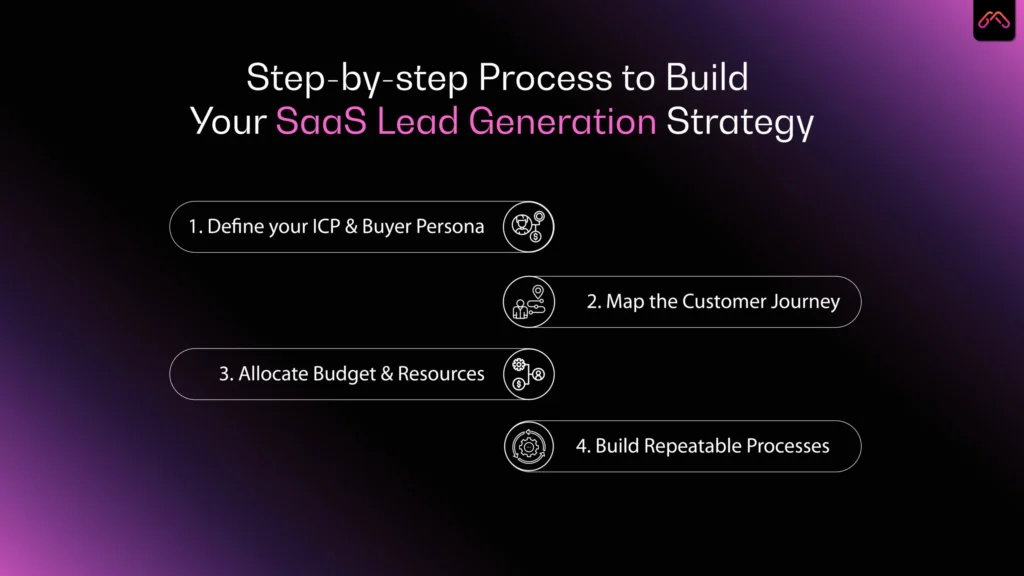
1. Define your ICP & Buyer Persona
A qualified lead isn’t just anyone who signs up; it’s someone who has the right problem, budget, and intent to buy your solution.
Start by identifying your ICP. Then build buyer personas that represent individual roles and their desires. Use CRM and analytics data to refine these personas continuously. This ensures your messaging, ad targeting, and outreach resonate with the right audience.
2. Map the Customer Journey
Leads interact with SaaS brands in stages: Awareness → Consideration → Decision.
At the awareness stage, they don’t know you yet, so strategies like SEO, content, explainer videos, and webinars work here. In Consideration, they’re comparing solutions: lead magnets, case studies, interactive tools, and retargeting ads are powerful during this stage.
And at Decision, they’re close to buying, so product-led growth, email campaigns, and chatbots will help you seal the deal.
3. Allocate Budget & Resources
Should you spend on Google Ads or go organic? The answer depends on your sales model and growth stage.
For an Inbound-heavy SaaS with longer sales cycles, you’ll likely invest more in SEO and content that attract and nurture leads over time, with a supporting layer of paid ads and automation tools.
But, for an outbound-heavy SaaS (enterprise deals), your major investment will go into sales reps and prospecting tools, while reserving resources for thought-leadership content, and webinars to support credibility.
4. Build Repeatable Processes
SaaS lead generation fails without consistency. That’s why you need systems that run on autopilot.
For instance, use automation to scale outreach without losing personalization. Create playbooks for sales teams and continuously run experiments and keep documenting what works so new team members can plug into proven processes.
Without a repeatable system, you’ll constantly start from scratch every quarter.
How to Improve Lead Quality in SaaS Marketing
We’ve already discussed proven ways to attract high-quality SaaS leads, but you may already have hundreds or thousands of leads in your pipeline who didn’t convert. The reason was probably not that they weren’t interested but that the experience wasn’t good enough.
So, instead of burning money chasing new prospects, squeezing more value out of the existing ones is a better option.
Here’s how you can do it:
1. Optimize Response Time
InsideSales’ research shows that contacting a lead within 5 minutes makes you 9x more likely to convert them than waiting an hour. For SaaS, this is even more crucial because alternatives are just a click away.
Use automated email sequences, chatbots, or sales alerts to ensure no lead goes cold while waiting for a reply.
2. Improve Your Lead Scoring Models
Not every lead deserves equal attention. By refining your leads based on engagement and intent signals, you help your sales team prioritize the hottest opportunities.
Tools like HubSpot, Marketo, or Clearbit can integrate data to score leads more accurately.
3. Segment for Personalization
Sending the same email to every lead rarely works. Instead, focus on segmenting your database based on demographics, behavior, and intent stage.
The more relevant your outreach, the higher your conversion.
4. Nurture Cold Leads with Targeted Campaigns
Many cold leads simply aren’t ready yet. Instead of discarding them, build nurture campaigns that keep your product top of mind. Over time, this steady exposure can warm them back up.
5. Re-Engage Leads with Fresh Offers
Every SaaS database has leads that are ghosted. Instead of ignoring them, bring them back with fresh offers: limited-time discounts, new feature launches, and updated content.
Conclusion
SaaS lead generation isn’t about getting more leads, but getting the right ones.
So, ensure to focus on qualified leads for SaaS. Build a mix of inbound and outbound SaaS marketing strategies. Use proven SaaS customer acquisition tactics and never stop optimizing.
Whether you’re a startup or scaling fast, these B2B SaaS lead generation principles will help you build a repeatable, growing system.
So, why wait? Start by refining your ICP, then pick one strategy from this guide and test it this week. Track your results, fix what’s missing, and see the growth.
And if you’re serious about boosting conversions, don’t avoid leveraging a well-crafted explainer video. It’s one of the fastest ways to turn confused visitors into qualified leads for SaaS because when people see your product in action, they get it instantly.
At MotionGility, we understand the pain points of every SaaS business owner and provide solutions that are not only effective but also ROI-driven, helping SaaS owners achieve their goals.
If you’re ready to add a high-performing explainer video to generate qualified leads, get in touch with us today, and let’s build something that moves the needle for your business.
FAQs about SaaS Lead Generation
1. What is SaaS lead generation, and why is it important for my business?
It’s how you attract potential customers for your software and it’s important because without a steady flow of qualified leads, your sales pipeline dries up and growth stalls.
2. How do I identify and attract qualified leads for my SaaS product?
Define your Ideal Customer Profile based on who actually converts, then use targeted content, SEO, explainer videos, and free trials to attract people who fit that profile.
3. Which lead generation channels are most effective for SaaS companies?
SEO and content marketing for long-term growth, LinkedIn and paid ads for quick wins, plus product-led tactics like free trials and explainer videos for high-intent conversions.
4. What strategies can help improve the quality of leads for a SaaS business?
You can create valuable lead magnets, use behavioral intent signals to prioritize hot leads, and let explainer videos pre-qualify prospects before they hit your sales team.
5. How can I measure the success of my SaaS lead generation efforts?
Track your MQL-to-customer conversion rate, Customer Lifetime Value (CLV), and which channels are actually driving revenue, not just traffic.


